Exploring Total Bath Systems: A Complete Guide
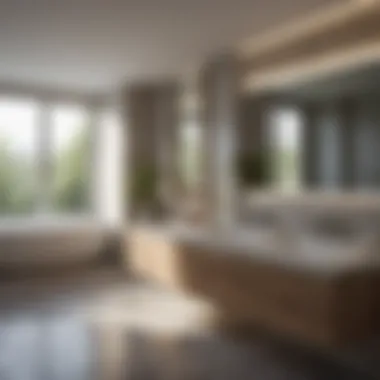
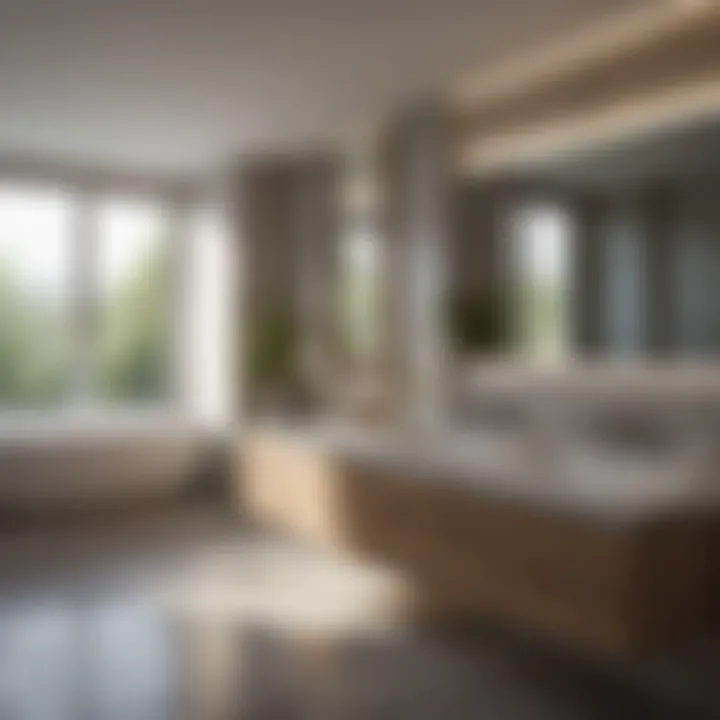
Intro
Total bath systems have become increasingly popular in recent years, appealing to homeowners looking to create a cohesive and stylish space. When considering a new bath setup, one must understand that it's not just about function; it’s also about forming an ambiance that aligns with personal tastes and lifestyle needs. This guide aims to unravel the various layers of total bath systems, diving deep into design trends, installation processes, and maintenance practices. By the end, you will have a comprehensive understanding of how to enhance your bath environment effectively.
Trending Styles
When it comes to bath design, the spectrum of styles available today is as vast as they come. Examining trending styles can provide excellent inspiration for homeowners and designers alike.
Modern Minimalism
The principle of modern minimalism is all about simplicity and functionality. Visual clutter is discarded in favor of clean lines and open spaces. Popular fixtures typically involve sleek vanities, wall-mounted faucets, and frameless glass enclosures. The goal is to create a serene atmosphere where everything is necessary but nothing is excessive. This style's neutral color scheme—think whites, grays, and earthy tones—enhances its tranquil vibe.
Cozy Rustic
In contrast to modern minimalism, cozy rustic designs evoke warmth and nostalgia. This style often features elements like wooden beams, natural stone, and warm lighting that beckon comfort. Imagine a beautiful clawfoot tub nestled against wooden paneling, surrounded by artisanal tiles. People are drawn to this style for its inviting aesthetics, perfect for unwinding after a long day. Incorporating bold patterns and earthy colors can enhance the rustic feel even more, revitalizing any bath.
Color Palettes
Color plays a pivotal role in your bath design, influencing not only aesthetics but also your mood. Knowing how to choose the right palette can drastically change the perception of your space.
Calming Neutrals
Opting for calming neutrals can create a peaceful retreat. Soft beiges, gentle whites, and muted grays can make a small bath feel larger and more airy. These colors naturally blend with various materials and textures, allowing for smooth transitions between the different elements of your space. Using these hues provides a sense of timelessness, ensuring your bath remains chic for years to come.
Bold Accents
On the other hand, integrating bold accents within a neutral palette can offer a delightful contrast. A bright teal vanity or a fiery red accent wall can serve as a focal point, adding personality and flair. The trick is to ensure these vibrant elements don’t overshadow the entire space; instead, they should serve to enhance the overall ambiance. A well-placed accent can breathe life into a neutral setting, making the bath feel unique and intentionally designed.
"Choosing the right style and color palette is just as important as the fixtures themselves. These elements come together to create an atmosphere that's truly your own."
By understanding these trends and palettes, homeowners can confidently tailor their total bath systems to reflect their unique tastes while ensuring functionality and practicality remain at the forefront. This knowledge sets the groundwork for what will come next in exploring the intricacies of installation and maintenance.
Preface to Total Bath Systems
In the ever-evolving realm of residential design, total bath systems have emerged as a focal point of functionality and aesthetics. These systems encapsulate various elements of bathroom design and installation, uniting essential components into a cohesive whole. The significance of understanding total bath systems cannot be understated, especially as we navigate through an age where both style and practicality hold equal weight in homeowner considerations.
Definition and Overview
At its core, a total bath system encompasses everything from bathtubs and showers to sinks, toilets, and fixtures. It is an integrated approach to bathroom design, ensuring each element works in harmony with the others. The idea here is not merely about placing these components together; it’s about curating an environment that feels cohesive and deliberate. When we define a total bath system, it's about recognizing that every piece plays a role in shaping user experience.
Traditional bathrooms often feel disjointed, but total bath systems strive to alleviate this by offering comprehensive solutions that marry both form and function. A well-thought-out total bath system will consider all variables—from layout to drainage—as well as how each choice interacts with another.
Importance in Modern Design
The importance of total bath systems in modern design cannot be overstated. As homeowners are more discerning than ever, there's a pressing need for spaces that are both welcoming and efficient.
- Spatial Efficiency: Total bath systems allow homeowners to maximize their space usage. By designing with intention, these systems provide solutions that accommodate needs without feeling cramped, especially in smaller urban apartments.
- Aesthetic Unity: Homeowners no longer view the bathroom as merely functional; they want it to mirror their tastes and lifestyles. A total bath system can offer consistent design language, from color palettes to materials, making the space feel polished and inviting.
- Enhanced Functionality: With advancements in technology, modern bath systems focus on enhancing user experience. Features like touchless faucets, smart showers, and integrated storage spaces elevate the bathroom from a routine necessity to a personalized retreat.
- Value Addition: Investing in a comprehensive bath system can significantly raise the market value of a home. Potential buyers often look for homes with updated, cohesive designs that require little to no renovation, making it a smart choice for future-proofing one's investment.
A thoughtfully designed total bath system doesn’t just serve its purpose; it transforms daily routines into enjoyable rituals.
Components of Total Bath Systems
Total bath systems are comprised of various elements that work together to create a functional yet stylish space. Each component plays a crucial role in ensuring not only ease of use but also the overall aesthetic appeal of the bathroom. Understanding these components offers valuable insights for homeowners looking to maximize their bath space, both in utility and design.
Bathtubs and Showers
When it comes to relaxation, bathtubs and showers often take the spotlight. The choice between a sleek shower enclosure and a comforting bathtub can set the tone for the entire room. Whether you opt for a freestanding tub that acts as a centerpiece or a minimalist shower that maximizes space, each option carries its weight in design considerations and practical functionality. Bathtubs can offer a tranquil retreat after a long day, while showers can provide a quick, invigorating escape, making it vital for homeowners to assess their lifestyle before making such choices.
Factors like water efficiency and the latest technology should also come into play when selecting these fixtures. For example, choosing a modern showerhead that conserves water while providing a luxurious experience contributes to sustainable living, a rising trend among bath enthusiasts.
Sinks and Vanities
Sinks and vanities are where form meets function. Selecting the right style can significantly enhance the overall appearance of your bath space. Whether you're going for a traditional look with porcelain sinks or something more avant-garde like a vessel sink, the sink's choice reflects personal style.
Vanities are particularly essential, providing storage for toiletries and offering a surface for everyday tasks. Consideration of the material is key – a wooden vanity can bring warmth, while metal finishes may contrast beautifully against tiled backsplashes. Functionality aside, they are often the first thing guests notice, hence the need to select one that ingrains sophistication into the design.
Toilets and Bidets
The choice of toilets has evolved; it’s no longer just a matter of basic necessity, but also comfort and style. Water-saving designs are now prevalent, pushing the envelope of modern toilets. Bidets, often seen as an essential in many cultures, are becoming increasingly popular. They provide not just hygiene but also can be regarded as a luxurious addition to any bathroom setup. Explore options that incorporate both toilets and bidets into one unit for optimal space management and an enhanced user experience.
Faucets and Fixtures
Faucets and fixtures, while small components, have a big impact on the overall feel of your bath environment. Select finishes that match or contrast with other elements for maximum aesthetic appeal. For example, pairing a matte black faucet with a classic white sink can create a striking visual contrast. Look for fixtures that are not only pleasing to the eye but also come with the latest developments in water efficiency. Beyond appearance, easy maintenance is essential, so opting for materials that resist tarnishing and corrosion will pay off in the long run.
Ultimately, the components you choose for your total bath system not only define its function but also reflect your personal style and values.
Design Considerations for Total Bath Systems
When it comes to crafting the perfect bathing sanctuary, the decisions made throughout the design process play a pivotal role. Well-considered design ensures that functionality, aesthetics, and comfort all harmonize. This section is crucial as it guides homeowners and designers through the vital elements that must be thought through to create a bath area that meets both style and practical needs.
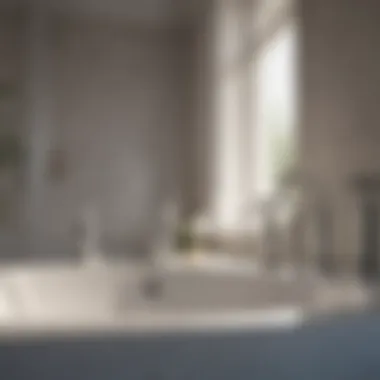
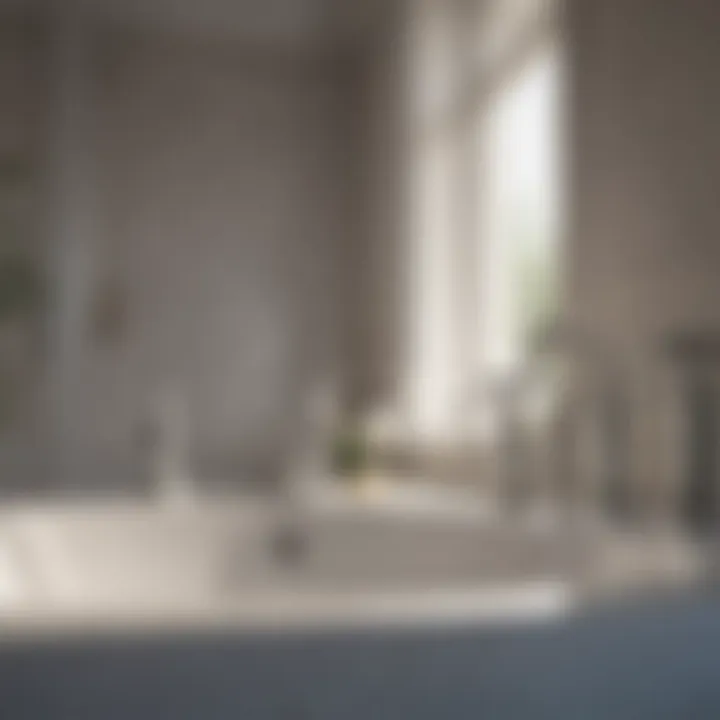
Spatial Planning
Spatial planning is where it all begins. This aspect focuses on the layout of your bath elements and the flow of the space. Ensuring everything is placed well can make the difference between a cramped area and an open, airy feel.
- Efficiency in Movement: Think of the typical routines and how people move. If you imagine a common scenario like brushing teeth or taking a shower, it's easy to see that having all elements within reach is key. Consider placements that minimize steps.
- Consideration of Size: Not all homes have the same amount of square footage, so understanding the proportions of your fixtures and space constraints is essential. A massive tub can dominate a small bathroom, leaving little room for anything else. Instead, a compact but luxurious shower might be the way to go.
In short, good spatial planning helps turn a chaotic bathroom into a tranquil retreat.
Material Selection
Choosing appropriate materials can significantly influence both the durability and look of the bathroom. Two major facets come into play here: durability and aesthetics, as well as environmental considerations.
Durability and Aesthetics
When one talks about durability, it’s not just about the lifespan of a material; it’s also about how well it withstands the wear and tear of everyday use. For instance, opting for quartz countertops over marble might be worth considering due to its robustness against stains and scratches.
- Key Characteristics: The strength of durability goes hand in hand with aesthetics. Homeowners want materials that not only last but also attract eyes. A beautifully veined quartz can check both boxes easily.
- Unique Features: Tiles that are both resistant to moisture and elegant in design, such as ceramic or porcelain, can elevate the room, marrying beauty and function seamlessly. However, it’s important to choose the right finish; glossy might be pretty, but can it stand up to slipperiness in a wet area?
Overall, achieving a balance between durability and aesthetics is beneficial. This has an impact on how the space feels and functions daily.
Environmental Considerations
As the conversation around eco-friendly designs grows, it is essential to consider how material choices affect the environment. Thus, using renewable materials that hold up against time while being kind to the planet is something to embrace.
- Key Characteristics: Materials like bamboo or recycled glass are gaining popularity for their minimal ecological footprint. Homeowners are becoming more particular about how their selections will impact the planet.
- Unique Features: Using water-efficient fixtures can lessen a home's overall water consumption. You save money on utility bills while contributing positively to the environmental cause. While they may come with a higher upfront cost, the long-term savings make them a popular choice.
Choosing eco-friendly materials represents a responsible choice for modern home design.
Color Schemes and Finishes
The final touch in any bath system is color schemes and finishes. The palette you choose can dictate the mood of the room significantly. Classic choices such as whites and greys exude a calm vibe, while bold colors can add an energetic flair.
Finishes also matter—matte surfaces can give a more subdued elegance compared to glossy ones.
Ultimately, these considerations culminate in a space that speaks to both individual style and practical concerns. A carefully designed environment transforms a simple bath area into a truly personalized sanctuary.
Installation of Total Bath Systems
The installation of total bath systems is a critical stage in ensuring that your bathroom not only looks good but is functional as well. It is one thing to have the right components; it’s another to fit them together in a way that meets the needs of your home and family. Proper installation guarantees durability and ensures that everything works as intended. It’s a step that can save you time and money in the long run if done properly, reducing the chances of future repairs or complications.
Professional vs. DIY Installation
Deciding between hiring a professional or tackling the installation yourself requires careful consideration. While going the DIY route may save on costs, it demands a clear understanding of plumbing and electrical systems. Mistakes can be costly. Professionals, on the other hand, bring expertise and experience that ensures every element is installed correctly the first time around.
In many cases, professionals are familiar with local codes, something that homeowners may overlook. If you opt for a DIY install, it’s paramount to conduct thorough research before jumping in.
Essential Tools Needed
No installation can be done without the right tools at your disposal. Here’s a list of essentials:
- Screwdrivers (Phillips and flathead)
- Pliers
- Pipe wrenches
- Drill
- Level
- Tape measure
- Utility knife
Having quality tools can streamline the process and make it more enjoyable. Notably, they can also prevent future issues that arise from poor installation, ensuring that every fitting stays tight.
Step-by-Step Installation Process
The actual installation process consists of several important steps you should always follow to ensure a smooth process.
Preparing the Space
Preparing the space is often the unsung hero when it comes to successful bathroom installation. This part is all about creating an environment that’s ready for the new system. It starts with clearing any clutter and establishing a workspace that allows you to move freely without knocking things over. Most importantly, ensuring that all utilities are turned off can prevent unexpected hazards.
A key characteristic of this phase is taking accurate measurements. It is a beneficial choice for avoiding costly mistakes later on. By mapping out where everything will go, you can save time and frustration during installation. This rapid assessment allows you to spot potential conflicts before they become issues.
Connecting Fixtures
Once the space is prepped, the next focus is connecting fixtures. This includes attaching faucets, hooking up pipes, and ensuring that everything aligns with your existing plumbing. This step is crucial as it involves working with water supply and drainage, areas where any slip-ups can lead to big headaches.
A critical aspect of connecting fixtures is ensuring a leak-free installation. Using proper seals and fittings not only will save you from water damage but will also elevate the longevity of your fixtures. On the flip side, if done incorrectly, leaks can lead to larger problems down the line.
Final Touches
With all elements connected, the final touches are the cherry on top of your new bath system. This can include sealing joints, applying caulk, and doing a thorough check to make sure that everything is functioning as it should. This phase offers a chance to correct any minor errors that may have been missed in previous steps.
A vital characteristic of this process is the attention to detail—small adjustments can make a world of difference in finishing your bathroom project beautifully. The unique feature here is that homes often present individual quirks that might need special attention, so being observant at this stage is advantageous.
"Taking your time during installation can save you from future headaches. Each step has its importance, and haste can lead to errors."
In summary, meticulous preparation, correct connections, and detailed finishing work culminate in an installation that not only functions well but also enhances the overall appeal of your total bath system. With all the tools and strategies above, navigating the installation process can be a manageable task, whether you’re going it alone or under the guidance of a pro.
Maintenance of Total Bath Systems
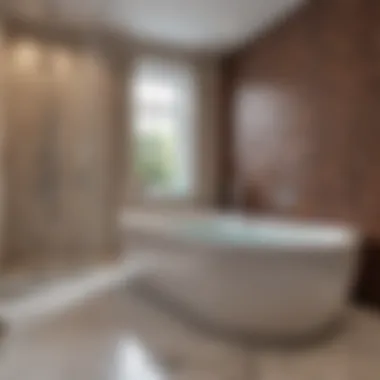
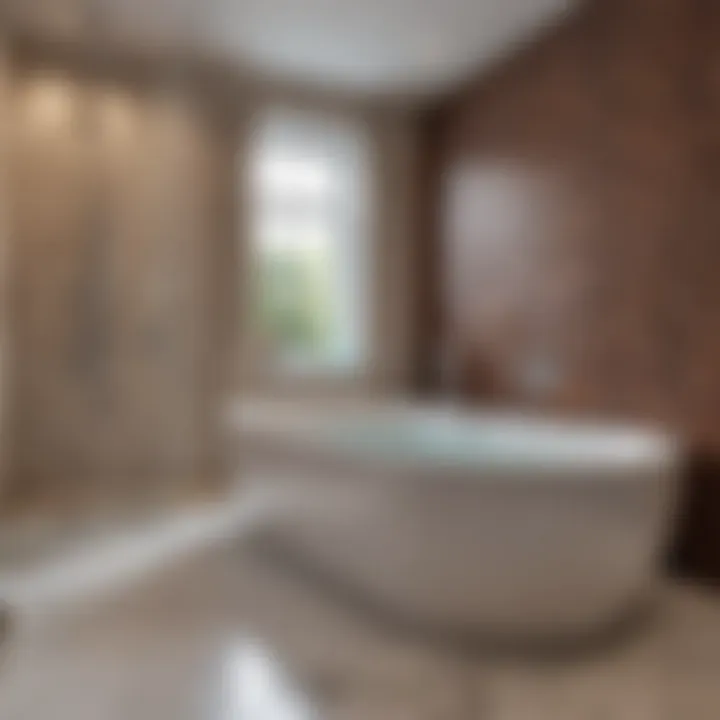
Keeping a total bath system in good working order is crucial for ensuring longevity and functionality. It's not just about squirtin' a little cleaner here and there; rather, it involves systematic care that can prevent issues from spiraling out of control. Homeowners who invest time in maintenance often find not only that their systems work better but also that they save money on repair costs in the long run. This section dives into the nuts and bolts of maintenance practices, outlines common problems encountered, and identifies when it's best to call a professional.
Regular Cleaning Practices
Cleaning your bath system is akin to keeping your car serviced; neglect can lead to bigger headaches down the line. Regular cleaning helps maintain the aesthetic appeal as well as function. Here are a few practices to consider:
- Weekly Surface Cleaning: Make it a habit to wipe down sinks, countertops, and mirrors weekly with a gentle cleaner to maintain shine.
- Tub and Shower Maintenance: After each use, consider rinsing your tub or shower to avoid soap scum buildup. A deeper clean once a month, using a stronger cleaner specifically for mildew, can work wonders.
- Grout and Tile: Don’t overlook the grout between your tiles. Scrubbing with a brush and a vinegar solution can keep those pesky stains from settling in.
Keeping these areas clean doesn't just boost appearance; it also prevents the growth of mold and other harmful bacteria.
Common Issues and Solutions
Clogs and Leaks
Clogs and leaks are two of the most prevalent issues in any bath system. The plumbing network is constantly working, and when something goes awry, it can feel like the world is crumbling.
- Clogs often develop due to hair, soap residue, and mineral buildup. Over time, these materials can block pipes, leading to slow drainage or a complete stoppage. The key characteristic of clogs is that they're usually controllable with preventative measures. Frequent use of a drain cleaner or simply using a hair catcher can drastically diminish these occurrences. However, they can also cause major headaches if left unattended, potentially leading to overflow or even structural damage.
- Leaks, on the other hand, can come from various sources: a worn-out faucet, damaged pipes, or poorly sealed fixtures. They can be silent, leading to unseen water damage, or obvious with puddles underneath sinks or toilets. Addressing leaks quickly can save water and protect your home's structure. The unique feature of leaks is their unpredictability; one minute everything's fine, and the next, you've got a drippy mess on your hands. Both clogs and leaks require vigilance but can often be managed with proactive steps.
Fixture Wear and Tear
Fixtures in a bath system endure a good deal of daily interaction, and wear and tear is inevitable. Recognizing when fixtures begin to show signs of aging sparks considerations for replacements.
- Faucets often wear down due to hard water or constant use, leading to cracks or inconsistent water flow. This affects not only functionality but also the aesthetic appeal of your bath. Keeping them clean can lengthen their life, but if water flow drops significantly or they're freezing up, replacing them might be necessary.
- Showerheads can accumulate mineral deposits, resulting in reduced water pressure. Regular cleaning helps, but when they start leaking or fail to spray evenly, it’s often time for a new one. Particularly modern fixtures tend to have finer mesh screens, leading to more blockages over time due to hard minerals.
Examining fixtures routinely can help you identify potential problems before they escalate into costly repairs.
When to Call a Professional
There are times when DIY solutions just won’t cut it, and calling a pro is the way to go. Define those moments based on the situation:
- Complex Repairs: If water is pooling unexpectedly or you can't locate the source of a leak, an expert can efficiently diagnose the issue.
- System Upgrades: When looking to enhance the system or make significant changes, like adding new fixtures or modifications, a skilled plumber can guide you in choosing the right approach.
- Time Constraints: Sometimes, you may simply have too much on your plate. Hiring a professional can ensure that the maintenance is done right, freeing up your time for other important tasks.
Proper maintenance is key to ensuring that your total bath system serves you well for years. By keeping the regular cleaning up and knowing when to dive into DIY fixes or call in the experts, you can create a harmonious and efficient space for your daily routines.
Enhancing the Experience with Accessories
Creating a warm and inviting atmosphere in a bath space isn't just about the fixtures and layout; accessories play a monumental role too. They serve not only as functional necessities but also as style statements. The right accessories transform a sterile environment into a sanctuary, making every visit to the bath a soothing experience. By incorporating thoughtful elements, homeowners can upgrade their personal haven from merely utilitarian to truly serene.
Bath Linens and Towels
Bath linens, including towels and bath mats, are not just practical; they're an extension of your personal style. Investing in high-quality towels can elevate the feel of your bathroom significantly. For instance, instead of a mismatched collection of towels, opt for a coordinated set in colors that complement your overall design scheme. Soft, plush towels not only absorb moisture more effectively, but they also encourage a sense of luxury every time they are used.
When choosing bath linens, consider both aesthetics and practicality. Towels made from natural fibers like cotton or bamboo are breathable and provide excellent softness against the skin. Add to that, a basket or rack for neatly organizing these towels, which keeps the space tidy and inviting.
Here are tips for selecting the best bath linens:
- Choose Towels with High GSM: A higher grams per square meter indicates denser and more absorbent towels.
- Color and Pattern Matters: Reflect the overall color scheme of your bath to create a seamless look.
- Maintenance: Make sure the towels are machine washable and durable enough to withstand regular use.
Lighting Solutions
Lighting can make or break the mood of your bath space. It's crucial to implement a layered lighting approach that combines ambient, task, and accent lighting. The right combination ensures functionality while also setting a calming ambiance. For example, installing dimmer switches allows you to adjust the light based on the time of day and mood.
Consider using sconces alongside the mirror for a warm, flattering light when applying makeup or performing skincare routines. Choose LED bulbs for efficiency without sacrificing quality.
Here are some lighting options worth considering:
- Wall-mounted Sconces: They provide great illumination without taking up counter space.
- Recessed Can Lighting: Offers a modern and sleek appearance.
- Natural Light: If possible, incorporate windows or skylights to bring in natural light, enhancing the refreshing feel.
Storage Options
Storage does more than keep your bath organized; it contributes to a sense of calm and order within the space. A clutter-free environment resonates tranquility, allowing for stress-free bathing rituals. From shelves to cabinets, having accessible and aesthetically pleasing storage is paramount.
Use baskets or bins to corral items like extra towels, bath products, or toiletries, keeping them within arm's reach but out of sight. Open shelves can double as display areas for attractive bottles or plants, marrying style with function.
Considerations for effective storage include:
- Choose Vertical Solutions: If space is at a premium, think vertically with tall shelving units.
- Under-sink storage: Use organizers to utilize the typically wasted space under the sink.
- Wall-mounted racks: They can hold items like hair tools and are often easy to install.
The right accessories not only serve a purpose; they tell your style story.
By thoughtfully selecting bath linens, lighting solutions, and storage options, you can elevate your overall bathing experience. Each element works in harmony to create a personalized retreat that feels like a spa, enhancing both functionality and comfort in everyday life.
Trends in Total Bath System Designs
In today's fast-paced world, the concept of bathroom design extends beyond mere functionality; it embraces an ethos of sustainability and technology that speaks volumes about personal and environmental wellness. Understanding current trends in total bath systems is essential for homeowners who want to create spaces that aren't just visually appealing but also beneficial for the planet and their overall experience.
Sustainable Materials
Sustainable materials are rapidly gaining traction in the world of bathroom design. Instead of opting for traditional choices that may contribute to environmental harm, more designers and homeowners are gravitating towards eco-friendly options. These materials can include bamboo, recycled glass, and even salvaged wood. Using such materials speaks to a commitment not only to aesthetics but also to a conscientious approach to crafting living spaces.
Here are some key benefits of choosing sustainable materials in bath systems:
- Lower Environmental Impact: Materials like recycled glass or reclaimed wood reduce the demand for virgin resources, thus lessening the ecological footprint.
- Healthier Living: Many sustainable options are free from harmful chemicals such as VOCs, making for a healthier environment.
- Durability: Often, these materials boast comparable, if not superior, durability, allowing for a wise investment in longevity.
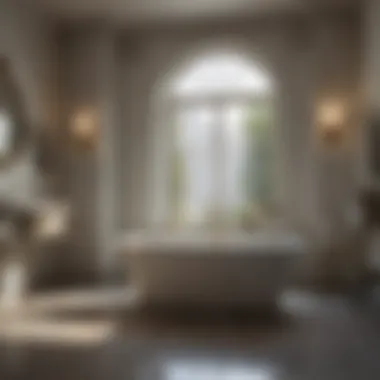

Apart from the environmental and health considerations, sustainable materials often present unique aesthetics. A bath fitted with natural, sustainable wood accents not only stands out but also sparks conversations.
"Using sustainable features in your bathroom can transform it into a sanctuary that embodies care for both the homeowner and the planet."
Smart Bath Technology
As the world becomes increasingly interconnected through technology, bathrooms are not left behind. Smart bath technology includes a range of features designed to enhance comfort, convenience, and efficiency. From intelligent toilets with heated seats and bidet functions to smart mirrors that display the weather or act as a virtual assistant, the evolution of our bathing spaces is staggering.
These innovations bring several advantages to the forefront:
- Convenience: Imagine stepping into a bath that knows your preferred water temperature and even adjusts the lighting based on your mood. Smart systems eliminate the guesswork, elevating your bathroom experience.
- Water Efficiency: Many smart fixtures are designed with water conservation in mind, significantly reducing water wastage without compromising performance.
- Remote Control: The convenience of being able to control your bath environment from your smartphone or voice command adds a layer of luxury that modern homeowners increasingly desire.
As a final note, the integration of such technology not only propels the functionality of bath spaces but also aligns with a sophisticated lifestyle that prioritizes both ease and style.
Embracing these trends in bath design has the potential to create an enriched experience for homeowners while also supporting a shift towards more responsible living.
Economic Considerations
Understanding the economic factors surrounding total bath systems is crucial for homeowners and designers alike. The investment in a bath system is not just about immediate costs; it involves long-term financial implications, potential for increased property value, and ongoing maintenance expenses. Recognizing these aspects can guide better decision-making while ensuring the investment leads to a desirable outcome.
Budgeting for Your Bath System
When embarking on a renovation or new construction project involving bath systems, budgeting often becomes a pivotal focus. It can be beneficial to outline a clear budget from the onset to mitigate overspending. This includes evaluating the costs associated with:
- Materials: From high-end finishes to more economical choices, material selection can substantially affect your budget. Assessing quality, durability, and aesthetic appeal is key.
- Labor: Whether opting for professional installation or a DIY approach, labor costs should be factored in. Experts can ensure correct installation, potentially saving money on repairs down the line.
- Fixtures and Accessories: Faucets, showerheads, and vanities can range widely in price. Prioritizing essential items while on a budget allows for flexibility in spending.
Modifying the budget as the project progresses might be necessary, especially when unexpected issues arise. Having a cushion within your budget can provide peace of mind during these situations.
Cost vs. Value Analysis
Another essential aspect to ponder is the cost vs. value analysis. In simple terms, you need to weigh the investment against the benefits you expect from the total bath system. This involves:
- Initial Costs: Look at the upfront costs related to installation and materials. For instance, opting for high-efficiency toilets might be a higher initial outlay but could lead to savings in water bills.
- Property Value Increase: A well-designed bath system can elevate a home’s market value. According to various real estate reports, high-impact bathrooms can offer excellent returns on investment.
- Ongoing Expenses: Consider maintenance costs over time. Some materials, while appealing initially, may require more upkeep.
"Investing in quality over merely lower price will pay dividends in the long run, both in terms of satisfaction and financial returns."
It is also advisable to research local market trends to understand what potential buyers are looking for. Categories of features that tend to appeal include modern technology, sustainable materials, and unique design elements. In synthesizing this information, a balance should be struck between enjoying your bath system today and tomorrow's potential returns.
In summary, keeping economic considerations at the forefront of your planning can help create a total bath system that not only suits your immediate desires but secures value for the future.
Case Studies and Real-Life Applications
Case studies and real-life applications serve as a pillar for understanding the practical implications of total bath systems. These examples paint a picture of how various components work together in both residential and commercial settings. These narratives showcase not only successes but also highlight pitfalls to avoid, offering valuable lessons for designers and homeowners alike. The significance of this section lies in its ability to provide contextual knowledge that theoretical guidelines cannot always capture.
Residential Transformations
In the realm of home improvement, residential transformations reveal the true potential of total bath systems. Imagine a dated bathroom with faded tiles and a cramped layout. A savvy homeowner decided to remodel, opting for a modern design that maximized both space and function.
The project featured a freestanding soaking tub paired with a sleek walk-in shower. This combination not only added a touch of luxury but also made the bathroom feel larger through strategic spatial planning. The use of light-colored marble and glass not only promoted a more open feel, but the materials also contributed to the bath system's durability, resisting daily wear and tear.
Moreover, let us look at how this transformation impacted the home's overall value. Post-renovation, the clinic condition enhanced the property’s market appeal, showing how an investment in a total bath system can yield future financial returns. Ultimately, these examples reflect a vital realization: an effective bath design fosters not only comfort but also instills a sense of pride in ownership.
Commercial Projects
On the other side, commercial projects showcase the importance of efficient design and functionality in public spaces. Numerous hotels and spas have undertaken total bath system renovations in recent years to cater to guest preferences. For instance, a well-known resort recently upgraded its bathrooms to include spa-like features such as rainfall showerheads and mood lighting.
These enhancements went beyond aesthetics; they were strategically designed to engage users through a serene experience. By integrating smart bath technology, like automatic faucets and temperature control systems, the commercial space ensured convenience while also addressing sustainability.
In addition, commercial applications often pit efficiency against luxury. Businesses must prioritize maintenance in high-traffic areas to reduce downtime. Companies that focus on installing durable materials and easily replaceable fixtures often save money and keep their baths looking fresh longer. The key takeaway from commercial projects is to blend user experience with operational efficiency.
In summary, both residential transformations and commercial projects highlight the practical application of total bath systems, providing insights into effective design and management while keeping user experience at the forefront.
Culmination
In the realm of total bath systems, concluding an exploration into their features and impact is paramount. This article has navigated various significant elements, from components to installation and maintenance, underscoring the relevance of each aspect in creating an efficient bathing space. Total bath systems are not merely a collection of fixtures; they represent an integrated approach to personal wellness and home aesthetics. The design choices made in these systems can lead to enhancements in functionality and comfort, while also showcasing individual style and preference.
Benefits of an Integrated Bath System
Implementing a total bath system streamlines the decision-making process for homeowners and designers alike. Achieving a cohesive look often results in a more pleasing atmosphere, which can transform the overall experience of using the bathroom. Moreover, by understanding the components and the interaction between them, one can attain a well-functioning system that meets specific needs, from luxury to practicality.
Key Considerations for Future Projects
When contemplating changes or upgrades, it’s essential to weigh options with a focus on adaptability and personal lifestyle. Compatibility between features like faucets, sinks, and tiles can inform choices that maximize space and usability. In summation, knowing how each element interacts contributes directly to a successful implementation of total bath systems.
No matter the size of the space, an informed approach to design and functionality will ensure the bathroom remains a sanctuary rather than just a utilitarian area.
Recap of Key Points
- Holistic Approach: The integration of different components fosters a unique space tailored for both relaxation and practical use.
- Installation Nuances: Choosing between professional help or a DIY venture can drastically affect cost and final quality, indicating deeper research is required.
- Maintenance and Care: Regular upkeep and knowing when to call for help can prolong the life of all fixtures and ensure continued satisfaction.
- Trend Awareness: Keeping abreast of new materials and technologies facilitates forward-thinking designs that enhance both sustainability and convenience.
Future of Total Bath Systems
Looking ahead, the total bath systems market is anticipated to grow significantly. With technological advancements, such as smart bath devices, emerging trends advocate for systems that cater to personal wellness and sophisticated designs. Integration of technology, like temperature control showers and touchless faucets, reflects changing consumer behaviors geared toward comfort and hygiene.
Sustainability in Focus
With an increasing emphasis on eco-friendly materials and practices, the industry is also shifting direction. Homeowners are now more empowered to incorporate sustainable choices in their renovations, leading to a greener footprint whilst also enjoying luxury. Notably, biophilic designs, which favor natural light and materials, are gaining momentum, creating serene environments that resonate with the body's natural rhythms.
Ultimately, the future of total bath systems is likely to be a combination of stylish, intuitive, and sustainable solutions that consistently meet the diverse needs and desires of homeowners.















